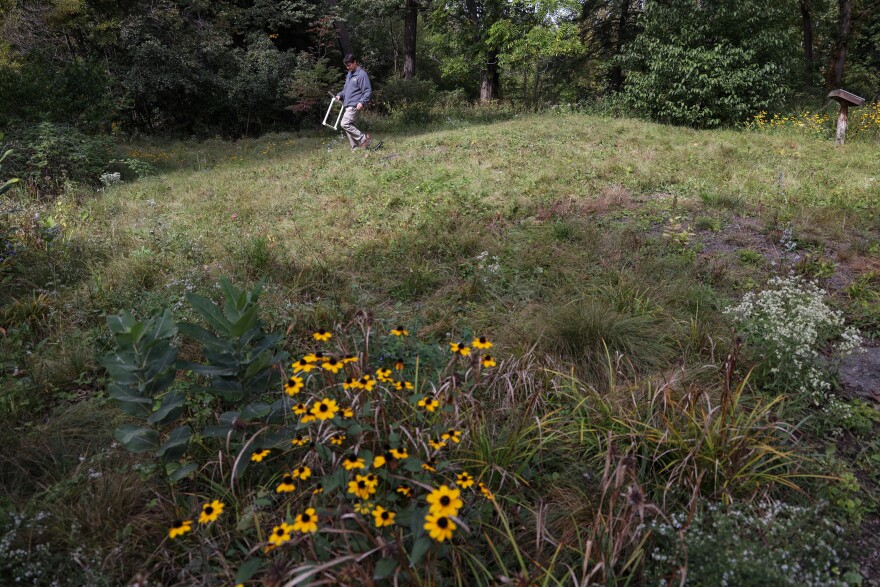On a mild, sunny September morning, Todd Bittner walks up to a neatly trimmed section of grass on the Cornell University campus.
This is where he likes to ask visitors, "Where are you right now?"
They usually reply, "Ithaca, New York."
But Bittner corrects them: "You are standing in Eurasia."
That's because even though it looks exactly like a lawn you'd find in any American neighborhood, the plants in this turf are almost exclusively non-native to our region.
Bittner then takes a few steps across a gravel path.
"Now you're in New York,” he says. “Eighty-five percent of the biodiversity we're looking at here is native plants."
Bittner is standing on a quarter-acre plot that is a designed plant community created 15 years ago as an alternative to the traditional lawn.
The indigenous species in this field might not all grow in the same space naturally, but they were each chosen for their specific ecological function. There are wildflowers scattered around silky tufts of grass. The star of the show, as Bittner calls it, is Danthonia spicata, or poverty oatgrass.

Some of the flowering plants — violets, asters, goldenrods, and black-eyed Susans — migrated here from a nearby woodland area.
One of the goals of this experiment is to open people's minds to the possibility of what their lawn could look like if they stepped away from the traditional expectations of a carpet of grass.
If the natural aesthetic is a hard sell for some, perhaps they would be persuaded by how much less work a native lawn requires.
Once it's established, Bittner says, it's almost maintenance-free.
"We wanted it to require no pesticide or fertilizers, to not need to be watered," he explains. "We actually only mow it once or twice a year, so it has significantly less carbon emissions."

The native lawn is also good at keeping turf weeds at bay, and it has benefits for wildlife. The more than three dozen native plant species here draw four times as many insect families than the non-native lawn just steps away. At the same time, the 8- to 10-inch-high plants don't appear to be a magnet for ticks.
"The diversity of plants begets the diversity of insect and rodent predators and mammal predators that eat ticks and so, we haven't found more ticks here than we find elsewhere," Bittner says.
These may be some of the reasons the movement away from the well-manicured lawn has picked up steam in recent years.
According to the National Wildlife Federation, nearly 20% of Americans were planning to transform at least a portion of their lawn to a native landscape in 2021.
That's more than double the rate from just a few years earlier.
Michael Warren Thomas has noted increased interest locally, too. The former city of Rochester horticulturalist says he respects the research that Cornell is doing, but he encourages people to think bigger.
"If you do the work of killing your existing lawn and replacing it with native grasses, I think it's a lost opportunity to add diversity and put in 40, 50, 60 different perennials and shrubs trees that will really feed nature in the way that even a native lawn can't really do," Thomas says.

Thirty years ago, he says, landscapers put an emphasis on low-maintenance plants that don't attract caterpillars or insects. Now, he wants to attract them.
"I don't want the invasive spongy moth to wipe out my tree," Thomas adds, "but ordinary caterpillars don't usually provide much visual damage. We want plants that are going to be consumed by insects. That's how Mother Nature works."
It should take about a year to establish a native lawn like the one at Cornell, according to Bittner. A webinar
Seneca Park Zoo sells nine different seed mixes on its website. And Genesee Land Trust has a native plant sale every spring. This year, they sold out in a little over an hour. They say they plan to expand their stock for next year to meet the growing demand.
If native lawn and garden enthusiasts encounter a raised brow from a neighbor, or local ordinances that adhere to the status quo, Bittner urges perseverance.
If his hunch is right, there will soon be another argument in their favor: Cornell is exploring the possibility that the significantly deeper roots of native plants are capable of capturing and storing higher levels of carbon dioxide from the atmosphere than a conventional lawn.



